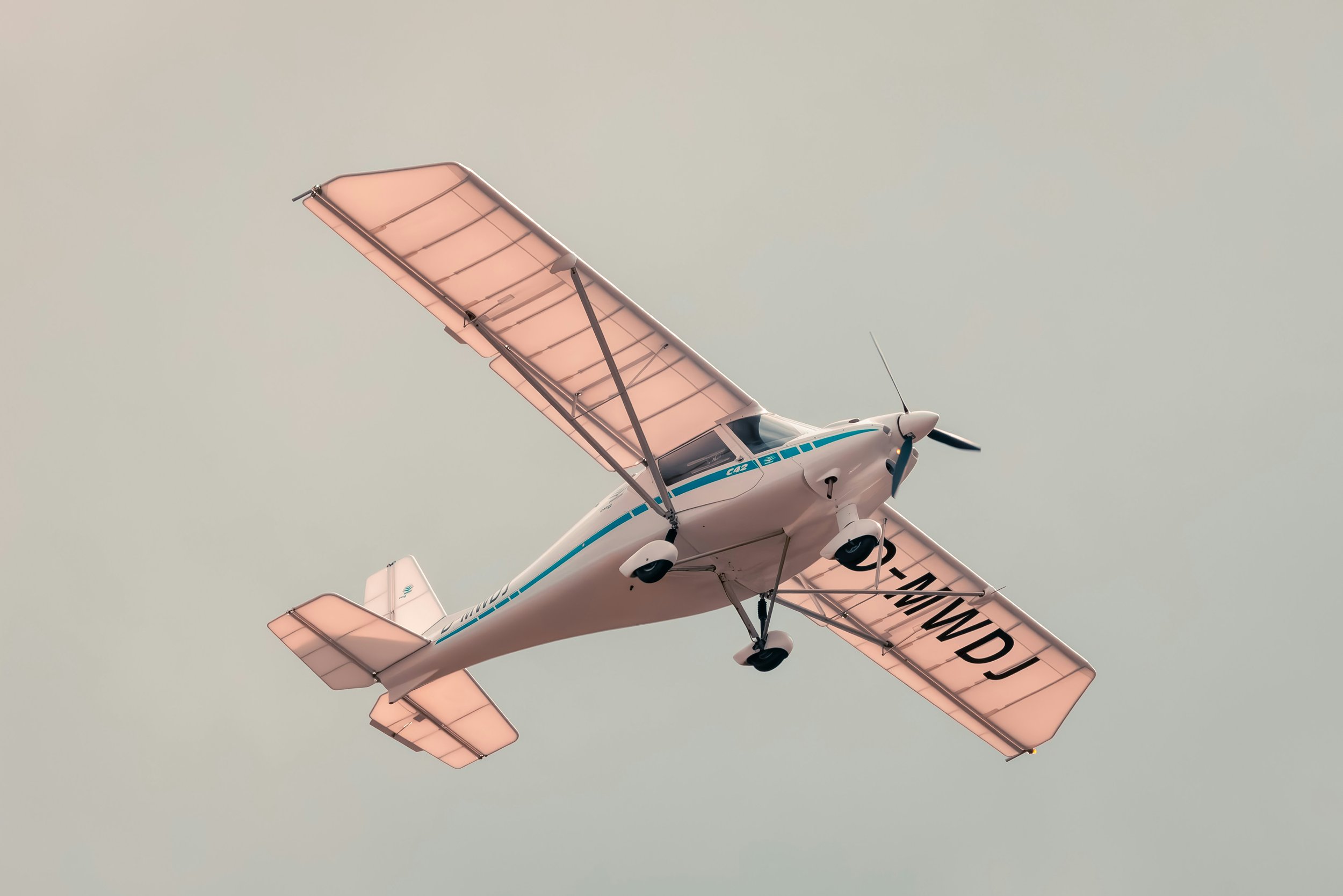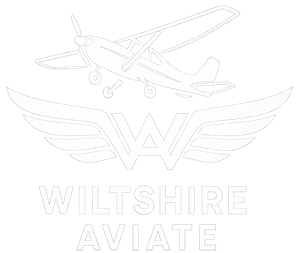
Learn to Fly in Wiltshire
A One to One Flying School in the Heart of Wiltshire
Microlight Flight Training in Wiltshire
Wiltshire Aviate offers 3-axis microlight flight training with Ikarus C42 aircraft.
With over 25 years’ experience, our expert instructor and examiner will professionally guide one to one microlight flying lessons from first flight to your General Skills Test.
Your Instructor
I’m Mark Hayter. I’m a flying instructor and examiner with over 25 years’ experience flying many types of microlight aircraft… I look forward to taking to the skies with you for your personalised training!
Our Services
The UK NPPL (M) microlight training syllabus is made up of 19 structured flight exercises, each designed to build your skills progressively and safely.
Under Mark’s guidance, you’ll work through each exercise step by step, covering essential aspects of microlight flying such as handling, navigation, emergency procedures and more.
Progression through the syllabus is based on demonstrated competence; Mark will only move on to the next exercise once you’ve fully mastered the current one. This ensures a strong foundation and prepares you thoroughly for your General Skills Test (GST) and solo flying.
-
A microlight trial flight is the perfect introduction to the exhilarating world of aviation, offering you the chance to take to the skies under the guidance of a qualified instructor. Whether you're considering pilot training or simply looking for a unique experience, a microlight experience flight allows you to get hands-on with the controls and see what it’s like to fly a light aircraft. Trial flights typically last between 30 to 60 minutes and include a pre-flight briefing, safety overview, and the opportunity to actually fly the aircraft yourself. No previous experience is required, making it ideal for first-timers, aviation enthusiasts, or those exploring the UK NPPL (M) route.
-
As part of your microlight flight training, you are required to complete and pass a General Skills Test (GST). This essential flight test is conducted by an authorized flight examiner and is designed to assess your ability to perform all the necessary flight manoeuvres you’ve learned during your training.
Successfully passing the GST demonstrates your competence and readiness to become a licensed microlight pilot. Importantly, the flight time recorded during the GST can be counted towards the minimum total flight hours required to obtain your UK NPPL (M). However, please note that GST time does not count toward the required solo flight hours.
GST Requirements and Validity
To ensure that your pilot skills and theoretical knowledge are up to date when applying for your licence, the following must be completed within the nine months prior to your NPPL application:
The required minimum solo flight time
All navigation flight training
The General Skills Test (GST)
This time frame helps ensure your flying competence is current and meets the Civil Aviation Authority (CAA) standards for safe microlight flying.
Components of the General Skills Test
The GST comprises two main parts:
Oral Ground Examination
Before the flight, you will undergo a verbal assessment to test your aviation knowledge, including airspace rules, weather interpretation, aircraft performance, and flight planning.Flying Section
During the in-air portion of the test, you must demonstrate practical flying skills such as takeoffs, landings, emergency procedures, and precision manoeuvres.
-
To continue flying legally in the UK, microlight pilots must ensure their UK NPPL (M) remains valid through regular microlight revalidation. Revalidation is essential for maintaining the legal currency of your licence and demonstrating your ongoing competence as a pilot. To revalidate your microlight rating, you typically need to complete a minimum of 12 hours of flight time, including at least 8 hours as Pilot in Command (PIC) and 12 take-offs and landings within the previous 24 months. Additionally, you must complete at least 1 hour of flight training with an instructor. If these requirements aren’t met, a Proficiency Check with an authorized examiner is necessary. Keeping your licence current through timely revalidation ensures you meet Civil Aviation Authority (CAA) standards and can continue enjoying safe, legal microlight flying.
-
If you already hold a pilot licence and wish to fly microlights in the UK, a microlight licence conversion allows you to transfer or upgrade your existing qualification efficiently. Pilots with licences such as the PPL(A), LAPL(A), or other ICAO-compliant licences may be eligible to convert to a UK NPPL with a microlight rating, subject to meeting Civil Aviation Authority (CAA) requirements. The conversion process typically includes a review of your flying experience, completion of any microlight-specific training, and a successful General Skills Test (GST) with an authorised examiner. In some cases, theory exams may be required if they are not already covered by your existing licence. Converting to a microlight licence is a practical way to enjoy the freedom and affordability of microlight flying while leveraging your current qualifications.
-
A bi-annual flight review is a crucial part of maintaining your microlight flying proficiency and ensuring you meet the Civil Aviation Authority (CAA) safety standards. Also known as a biennial flight review or microlight instructor flight check, this assessment must be completed every 24 months and involves flying with a qualified microlight flight instructor. The purpose of the bi-annual check is to refresh essential flight handling skills, reinforce airspace and procedural knowledge, and address any areas needing improvement. It is not a test, but rather a structured opportunity to review and update your flying abilities, ensuring continued confidence and competence in the air. Completing your bi-annual microlight check helps maintain legal currency and supports safer flying for all pilots.
-
A tailwheel conversion is essential for microlight pilots who wish to fly taildragger aircraft, which require different handling skills compared to nosewheel designs. Tailwheel microlights are popular for their performance, simplicity, and traditional flying feel - but they also demand greater precision, especially during take-off and landing. A tailwheel differences training course with a qualified microlight instructor will teach you the specific techniques needed for safe and confident tailwheel aircraft operation. Training includes ground handling, crosswind techniques, directional control, and three-point and wheel landings. Upon successful completion, your tailwheel endorsement will be recorded in your logbook, enabling you to legally operate tailwheel-configured microlights. Whether you’re looking to fly vintage-style aircraft or develop more advanced stick-and-rudder skills, a microlight tailwheel conversion is a valuable addition to your pilot training.
-
Short strip training is an essential skill-building course for microlight pilots who want to safely operate from short or challenging airstrips. Whether you’re flying from farm strips, private fields, or remote locations, this specialised training teaches you the critical techniques needed for short-field take-offs and landings, obstacle clearance, energy management, and precise aircraft control. With guidance from an experienced microlight instructor, you'll learn how to assess runway conditions, adjust performance based on weather and weight, and apply advanced STOL (Short Take-Off and Landing) procedures. Completing a short strip training course not only boosts your confidence and safety, but also greatly expands the range of microlight flying locations available to you. It’s a valuable addition for any pilot aiming to fly in real-world, off-airfield environments.
-
As part of your journey to becoming a qualified microlight pilot, you must pass a series of microlight ground exams to demonstrate a solid understanding of aviation theory and safety procedures. These written exams are a key requirement for obtaining your UK NPPL with a microlight rating, as set by the Civil Aviation Authority (CAA). The ground school subjects typically include Air Law, Human Performance, Navigation, Meteorology, Aircraft Technical Knowledge, and Operational Procedures. Each exam tests your ability to apply theoretical knowledge in real-world flying situations. Ground exams can be taken individually and are often conducted at your local microlight flight school. Studying for and passing these exams ensures you have the essential aviation knowledge to make informed decisions, manage in-flight situations, and fly safely and confidently.
-
Minimum hours flight training required to gain UK NPPL with microlight class rating (without restrictions) is:
Minimum total flight time under instruction = 25 hours
Minimum flight time solo = 10 hours
Minimum total navigation flight time = 5 hours
Minimum total solo navigation flight time = 3 hours.
All solo hours and navigation have to be current and need to be completed within a 24 month period.
Training Costs
Fly On Over
Membury Airfield
Hungerford, RG17 7TJ
Find Us: From the M4 motorway flyover on Ramsbury Road, take the fourth exit on the right and follow the tracking and signs for ‘British Young Pilots’. We are located in the wooden cabin to the right rear of the car park.
Enquiries
Please Call or Email


